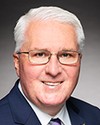moved:
That:
(a) the House recognize that an assessment by the International Association of Fire Fighters concluded significant regulatory shortfalls concerning emergency responses at Canada's major airports are needlessly putting the safety of the flying public at risk, by
(i) failing to specify rescue as a required function of airport fire fighters,
(ii) requiring only that fire fighters must reach the mid-point of the furthest runway in three minutes rather than all points on operational runways within that time period; and
(b) in the opinion of the House, the government should, without delay, ensure that the Canadian Aviation Regulations reflect airport rescue and firefighting standards published by the International Civil Aviation Organization, specifically by
(i) giving fire fighters at Canada's major airports the mandate and resources necessary to reach the site of a fire or mishap anywhere on an operational runway in three minutes or less,
(ii) specifying that a required function of fire fighters be the rescue of passengers.
Madam Speaker, the purpose of Motion No. 96 is to close what many, especially who know the fire and rescue profession, see as significant and dangerous gaps in the ability to respond effectively to aircraft accidents at major Canadian airports.
Motion No. 96 calls for the Government of Canada to close these gaps by amending the Canadian aviation regulations to bring them in line with standards published by the International Civil Aviation Organization, a United Nations agency headquartered in Montreal.
Specifically, closing the safety gap involves three measures: including rescue as well as firefighting in the mandate for firefighters at Canada's major airports; mandating a response time of no more than three minutes for fire rescue equipment to reach any point on an operational runway; and specifying the number of personnel required to meet fire rescue standards.
People have been raising attention to the lack of a rescue mandate for at least 25 years. The April 1 edition of Fire Engineering reported a Department of National Defence document quoting an item in the Canadian Press, suggesting “firefighting standards at civilian airports in Canada aren't up to snuff and may even put lives at risk”. The report draws attention to life-threatening dangers faced by occupants of aircraft who are not able to walk away from a wreck because Transport Canada only requires airport firefighting crews to assist in rescue outside the craft. The DND reported that the primary responsibility for rescue from inside the craft is left to the airline's flight crews and local fire departments. I will say more on that a bit later.
In its 30th Canadian legislative conference, held in Ottawa at the end of March, the International Association of Fire Fighters raised the issue again. This time, we in Parliament have an opportunity to respond and close the gaps.
Transport Canada's standard 323 in its Canadian aviation regulations states, “an aircraft fire-fighting service is a contingent resource tasked with the primary responsibility of providing a fire free egress route for the evacuation of passengers and crew”.
Section 323.03, on general requirements, adds:
This standard is not intended to limit the fire-fighting service from providing services in addition to that of aircraft fire-fighting at the airport or aerodrome, nor to prevent it from dealing with other occurrences.
Some I have spoken to reflected that firefighters can be assigned other duties while on shift, such as cutting the grass, that could well increase the turnout time for a call. Regardless, the reality at most of Canada's major airports is that fire crews do not have the personnel or, perhaps, even the training or equipment to step beyond this basic mandate, which is now limited to fighting the fire, trying to keep an escape route open and hoping that whoever is inside the aircraft can make it out.
Transport Canada's outline of the requirements to comply with the current Canadian aviation regulations focuses on fire extinguishing agents and the testing of the equipment needed to ensure the correct discharge rate and the reach the foam can get to when out fighting a fire. The section on training of personnel focuses almost exclusively on responding to an aircraft fire, with one reference to emergency aircraft evacuation assistance. If this measure refers to anything more than keeping open an escape route through the flames, the reality of staffing makes it only aspirational at some, if not most, Canadian airports. In discussions with the firefighters association, I was told that the staffing requirements on a rig dispatched to extinguish a fire is two firefighters: One drives and assists the second firefighter to discharge the foam.
If firefighters are charged with the additional mandate to rescue aircraft occupants from inside the craft, I am told that they would almost certainly need to rely on the two-in, two-out rule: If personnel are sent into any burning structure, there must be at least two firefighters outside to be there if it becomes necessary to rescue their colleagues inside.
We cannot ask firefighters to risk their lives, as they most certainly do when they go in to rescue people, without the support and backup needed if things go terribly wrong. A two-person response team today would then become maybe four, six or more. Bolstered fire hall complements, plus any necessary equipment and rescue training, would all be necessary to bring the Canadian aviation regulations up to ICAO standards.
A number of us in this place are exposed to the broadest range of risks when we fly to and from our ridings to be here for our parliamentary duties and to go back home and help our constituents, and I am one of them.
An assessment of the fire and rescue capabilities in Canada puts Vancouver International Airport at, or near, the top. That is where I usually originate my trips to come to Ottawa. In 2022, YVR recorded 230,162 runway movements and passenger counts of over 19 million. This is a lot, though it is still far short of the prepandemic total of 25.9 million passengers, but it is quite likely that volume will be reached and exceeded relatively soon. I would estimate, judging from the passengers I see at YVR, that this year will probably see the old level reached quite handily. I am told that the Vancouver Airport Authority has voluntarily adopted standards that meet or are very close to the ICAO standards.
At the other end of the journey for most MPs from metro Vancouver, we have the Ottawa International Airport. It is cited by the IAFF as one of the most challenged in meeting ICAO standards. In preparation for today, I reviewed the “YOW 2038 Master Plan”. I looked through it, and currently, there does not appear to be any provision in that plan to close any kind of a fire rescue gap.
I am told Pearson airport in Toronto is close to meeting the higher standards, and most Canadian airports, at least the 25 to 30 larger airports with more than 180,000 enplaned or deplaned passengers per year that are subject to the Canadian aviation regulations, face greater challenges than Vancouver or Toronto.
The second gap is the response time to an incident. The ICAO standard is three minutes for a fire rescue response to any point on an operational runway. I am told the Canadian standard is three minutes to the midpoint of any operational runway.
Let us have another look at the Ottawa airport. The fire hall is located very close to the end of its longest runway, which runs north-south and is 3,049 metres long. Current regulations require firefighters to reach the midpoint in three minutes, and I am told that they can do that in just under three minutes. However, it would be a challenge for them, if we are looking at a worst-case scenario of four minutes or five minutes for a crew to receive an alarm, turn out and reach an incident at the farthest end of that longest runway. I have not been able to find any records on YOW's actual performance in exercises or incident responses, but a resource here with us this evening has said that they can do the three minutes. Beyond that, it is pretty dodgy.
By the way, when we talk about meeting the standards, we should not for an instant doubt the dedication and professionalism of the firefighters. The focus here is on enabling them to meet high standards efficiently and, above all, safely.
Ottawa's airport is one of those ones that relies on the aircrew on board a burning aircraft to get the people to the door and outside, where the current regulation says that the fire department has to keep a pathway clear so that the people can get away from the aircraft. If it is to be fire rescue, they have to rely on the Ottawa civic firefighting service. The fire hall on McCarthy Road is nine driving minutes from the airport, and the hall on Leitrim Road is 11 minutes away. That is driving time. That does not count the turn-out time or getting the person out of the back or wherever they happen to be when the alarm comes in.
To the extent that Canadian airports have been designed like YOW, it could very well be that meeting ICAO's response time would require the relocation of fire halls. As I mentioned, the fire hall at YOW is at just about the end of the longest runway. That leads to the issue of costs, of course. In a 2003 regulatory impact analysis statement, the definition of “rescue” was specifically drafted, “to ensure that the status quo will be unchanged with the types of activities included as aircraft rescue and fire-fighting services” without imposing any additional obligations or costs.
Let us think about that for a moment. In these times, when passengers pay a surcharge of, let us say, $12 a ticket for security costs and $35 or more, in fact, in airport improvement fees, the IAFF suggests that an additional surcharge of 50¢, a dollar or, in the case of a smaller airport, maybe two, three, four or five dollars might be necessary to fund the lifting of services up to the ICAO standards. Canadians love to travel, especially by air. I certainly see a lot of evidence of that here in Ottawa or in Toronto, which I go through. I occasionally see it in Montreal and certainly at YVR. Those airports are jammed. I am seldom on an aircraft that has any empty seats. In spite of the narrative that says the country is broke and nobody can do anything, there sure seems to be a lot of money around for air travel these days. Therefore, we have to wonder whether maybe a few bucks per ticket to bolster the ability of aircraft passengers and crew to survive an accident at Canada's key airports is really too much to ask. Of course, the proposition here is no.
In preparing for this debate on Motion No. 96, I have been inspired by the hon. member for Longueuil—Charles-LeMoyne, whose private member's bill, Bill C-224, which we passed unanimously, has paved the way for a national framework to raise awareness of cancers linked to firefighting and to improve access to cancer prevention and treatment. When it appeared I had this opportunity, she was the first to promote resolving the regulation gaps as an important, worthy and complementary initiative, one that could support our firefighters even further by delivering critical safety improvements for air crews, air passengers and, yes, firefighters too. I would like to thank the Library of Parliament and our legislative assistant Riley Sutton for their assistance in researching this issue. I would also like to thank, of course, the International Association of Firefighters and firefighters from the Ottawa airport, who are helping to keep this issue alive.
I am now looking forward to hearing the perspective of our colleagues, because when Motion No. 96 came out, we received notes from members of the other party asking what it was all about. We provided the information we had, and I know they have been doing their own research and will be in a position to maybe expand on some of the points I have been able to raise this evening. Therefore, I will be very pleased to cede the floor to questions if there are any and certainly to my colleagues to expand on the need for Motion No. 96.













